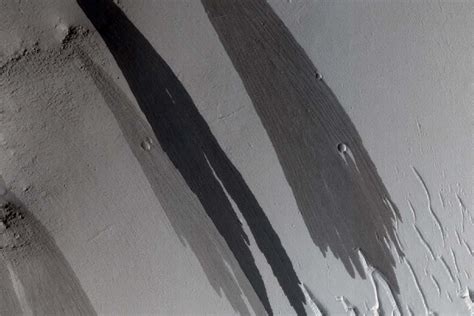
Long, dark streaks that seasonally appear on Martian slopes, once suspected to be evidence of flowing liquid water, are likely caused by dry granular flows, according to new research. These recurring slope lineae (RSL), which appear during warmer months and fade in cooler temperatures, are now believed to be the result of sand and dust avalanches, not brine flows as previously hypothesized.
The mystery surrounding the dark streaks on Mars has taken a new turn as scientists challenge the long-held belief that liquid water is the primary driver behind their formation. A recent study indicates that these features, known as recurring slope lineae (RSL), are more likely the result of dry granular flows, similar to avalanches of sand and dust. This finding alters our understanding of Martian surface processes and the potential for liquid water activity on the planet today.
For years, the RSL, which appear as dark streaks on steep slopes during warmer seasons and then fade away as temperatures drop, have intrigued scientists. Their seasonal behavior and dark appearance led to the hypothesis that they were formed by the flow of salty liquid water, or brines. This hypothesis fueled excitement about the possibility of present-day liquid water on Mars, which would have significant implications for the planet’s habitability and potential for past or present life.
However, the new research, based on detailed analysis of high-resolution images and topographic data from the Mars Reconnaissance Orbiter (MRO), suggests a different explanation. The study focuses on the slopes where RSL are observed, finding that they are consistent with the angles of repose for dry granular materials. The angle of repose is the steepest angle at which a pile of granular material, such as sand or gravel, can remain stable. According to the research, the RSL slopes match this angle, indicating that they are likely formed by the downhill movement of dry sand and dust, rather than the flow of liquid water.
“We’ve spent a lot of time looking at the RSL,” said Colin Dundas, a research geologist at the U.S. Geological Survey’s Astrogeology Science Center in Flagstaff, Arizona, and lead author of the new study. “The explanation that reconciled all the observations was the movement of dry material.” Dundas further emphasized that this conclusion aligns with the dry conditions known to exist on the Martian surface.
This new theory doesn’t completely rule out the possibility of water playing a role in the RSL formation indirectly. It’s possible that small amounts of water vapor from the atmosphere could interact with the surface materials, influencing their behavior. However, the research strongly suggests that the visible dark streaks are not caused by substantial flows of liquid water.
The implications of this finding are significant for our understanding of Mars. It suggests that the planet may be even drier than previously thought, reducing the likelihood of finding readily accessible liquid water near the surface. This, in turn, impacts our assessment of the planet’s habitability and the potential for supporting life.
Furthermore, this research highlights the importance of continued exploration and investigation of Mars. While the mystery of the RSL may not be entirely solved, this new study provides a compelling alternative explanation that is supported by observational data. It also underscores the complexity of Martian surface processes and the need for more sophisticated techniques to understand the planet’s environment.
The Mars Reconnaissance Orbiter, which has been studying Mars since 2006, continues to provide valuable data that is helping scientists unravel the mysteries of the Red Planet. The High-Resolution Imaging Science Experiment (HiRISE) camera on board the MRO has captured detailed images of the Martian surface, allowing researchers to study features like the RSL with unprecedented clarity. The Compact Reconnaissance Imaging Spectrometer for Mars (CRISM), also on the MRO, has provided spectral data that has been used to analyze the composition of the RSL and surrounding areas.
The research team also used digital terrain models derived from HiRISE stereo images to measure the slopes of the RSL. This allowed them to determine that the slopes were consistent with the angle of repose for dry granular materials.
The findings of this study have been published in the journal Nature Geoscience. The research was supported by NASA’s Mars Reconnaissance Orbiter project.
The shifting understanding of RSL serves as a reminder of the evolving nature of scientific knowledge. As new data and analytical techniques become available, our understanding of the universe, including our neighboring planet Mars, continues to evolve. While the prospect of flowing water on Mars was an exciting possibility, this new research provides a more realistic and nuanced picture of the Martian environment. It also emphasizes the need for continued exploration and investigation to fully understand the Red Planet and its potential for past or present life.
The discovery of RSL initially sparked tremendous interest because the presence of liquid water, even in the form of brines, would significantly increase the possibility of microbial life existing on Mars. Liquid water is essential for all known life forms, and its presence on Mars would suggest that the planet might have been habitable in the past, or even harbor life today.
The initial hypothesis was that the RSL were formed by the seasonal melting of subsurface ice, or by the upwelling of salty groundwater. These brines, with their lower freezing points, could remain liquid even at the cold temperatures found on the Martian surface. This would explain the seasonal appearance and disappearance of the RSL, as well as their dark appearance, which was thought to be due to the presence of hydrated salts.
However, subsequent research has cast doubt on this hypothesis. Studies have shown that the RSL are located in areas that are too dry and cold for liquid water to exist for extended periods. Furthermore, spectral analysis of the RSL has failed to detect the presence of hydrated salts, which would be expected if they were formed by brines.
The new research provides a more plausible explanation for the RSL, based on the physics of granular materials. The angle of repose is a fundamental property of granular materials, and it determines the maximum slope at which a pile of these materials can remain stable. When the slope exceeds the angle of repose, the material will start to flow downhill, creating a landslide or avalanche.
The fact that the RSL slopes match the angle of repose suggests that they are formed by the downhill movement of dry sand and dust. This process could be triggered by various factors, such as thermal expansion and contraction of the surface materials, or by small seismic events.
The new theory also explains why the RSL are seasonal. During the warmer months, the surface materials expand and contract more, making them more likely to flow downhill. During the colder months, the surface materials are more stable, and the RSL fade away.
While the new research provides a compelling explanation for the RSL, it does not completely rule out the possibility of water playing a role. It is possible that small amounts of water vapor from the atmosphere could interact with the surface materials, influencing their behavior. For example, water vapor could condense on the surface of the grains, making them stickier and more likely to flow downhill.
However, the research strongly suggests that the visible dark streaks are not caused by substantial flows of liquid water. This has significant implications for our understanding of Mars and its potential for supporting life. If the RSL are not formed by liquid water, then the chances of finding readily accessible water near the surface are significantly reduced. This would make it more difficult to establish a human presence on Mars, and it would also reduce the likelihood of finding microbial life.
Despite this setback, the search for water on Mars continues. Scientists are exploring other areas of the planet that may be more likely to harbor water, such as the polar regions and the subsurface. They are also developing new technologies to detect and extract water from the Martian environment.
The Mars Reconnaissance Orbiter continues to play a crucial role in this effort. The MRO is equipped with a variety of instruments that can be used to study the Martian surface and atmosphere in detail. These instruments are helping scientists to identify potential sources of water, and to understand the processes that control its distribution and behavior.
The exploration of Mars is a long and challenging endeavor, but it is also one of the most exciting and important scientific endeavors of our time. By studying Mars, we can learn more about the origin and evolution of our solar system, and we can also gain insights into the potential for life beyond Earth.
The RSL research emphasizes the dynamic nature of Mars. It’s not a static, dead world but one with ongoing geological processes, even if they are primarily driven by dry mechanisms. Further research will undoubtedly continue to refine our understanding of these processes and the overall environment of the Red Planet. Future missions could focus on directly measuring the composition and behavior of the surface materials in RSL areas to further validate the dry granular flow theory. This could involve landing probes equipped with instruments to analyze the soil properties and monitor the movement of particles over time.
Furthermore, studying similar granular flows on Earth can provide valuable insights into the processes occurring on Mars. By comparing the characteristics of terrestrial and Martian granular flows, scientists can develop a better understanding of the factors that influence their formation and behavior.
The revised understanding of RSL doesn’t negate the importance of water on Mars entirely. Evidence suggests that water ice exists in the polar regions and subsurface, and there’s compelling geological evidence of past liquid water activity. The focus shifts from readily available surface water to a more nuanced understanding of how water, even in limited quantities or different forms, might still influence Martian surface processes and potentially contribute to localized habitable environments.
It’s important to consider the broader context of Martian habitability. Even if readily accessible liquid water is scarce, other factors such as the presence of organic molecules, sources of energy, and protection from radiation could contribute to the potential for life. The search for life on Mars is a multifaceted endeavor that requires a comprehensive understanding of the planet’s environment and its history.
The investigation of RSL serves as a testament to the scientific process. Initial interpretations, based on the best available data at the time, led to the hypothesis of flowing water. As more data was collected and new analytical techniques were developed, the hypothesis was challenged and refined. This iterative process is essential for advancing our understanding of the universe and for ensuring that our knowledge is based on the most accurate and reliable evidence. The case of the RSL highlights the importance of remaining open to new ideas and of being willing to revise our understanding in light of new evidence.
The future of Mars exploration holds immense promise. With ongoing missions like the Mars Reconnaissance Orbiter and the Perseverance rover, and with future missions planned by various space agencies, we can expect to continue making significant advances in our understanding of the Red Planet. These missions will provide us with more detailed data, more sophisticated analytical techniques, and new opportunities to explore the Martian environment. The ultimate goal is to unravel the mysteries of Mars, to understand its past, its present, and its potential for the future.
FAQ
1. What are Recurring Slope Lineae (RSL)?
Recurring Slope Lineae (RSL) are dark, narrow streaks observed on steep slopes on Mars that appear and lengthen during warmer seasons and fade during colder periods. They have been a subject of scientific interest due to the initial hypothesis that they might be evidence of flowing liquid water.
2. What was the original hypothesis about the formation of RSL?
The original hypothesis proposed that RSL were formed by the flow of salty liquid water, or brines, on the Martian surface. The presence of brines would lower the freezing point of water, allowing it to exist in liquid form even at the cold temperatures found on Mars.
3. What is the new theory explaining the formation of RSL?
The new theory suggests that RSL are likely formed by dry granular flows, similar to avalanches of sand and dust. This theory is based on the observation that the slopes where RSL are found match the angle of repose for dry granular materials, indicating that they are likely formed by the downhill movement of dry materials.
4. What evidence supports the new theory?
The evidence supporting the dry granular flow theory includes the analysis of high-resolution images and topographic data from the Mars Reconnaissance Orbiter (MRO). The research team measured the slopes of the RSL and found that they were consistent with the angle of repose for dry granular materials. Furthermore, spectral analysis of the RSL has not detected the presence of hydrated salts, which would be expected if they were formed by brines.
5. What are the implications of this new theory for the possibility of life on Mars?
The new theory suggests that the planet may be even drier than previously thought, reducing the likelihood of finding readily accessible liquid water near the surface. This, in turn, impacts our assessment of the planet’s habitability and the potential for supporting life. While it doesn’t completely rule out the possibility of water playing a role indirectly, it suggests that the visible dark streaks are not caused by substantial flows of liquid water. 6. What does “angle of repose” mean in the context of this study?
The angle of repose is the steepest angle at which a pile of granular material, such as sand or gravel, can remain stable. If the slope exceeds the angle of repose, the material will start to flow downhill. The RSL slopes matching this angle is a key piece of evidence supporting the dry granular flow theory.
7. How was the data collected and analyzed for this study?
The data was collected by the Mars Reconnaissance Orbiter (MRO), particularly using the High-Resolution Imaging Science Experiment (HiRISE) camera and the Compact Reconnaissance Imaging Spectrometer for Mars (CRISM). HiRISE provided detailed images of the Martian surface, while CRISM provided spectral data used to analyze the composition of the RSL. Digital terrain models derived from HiRISE stereo images were used to measure the slopes.
8. Does this new research completely rule out the possibility of water on Mars?
No, the research doesn’t completely rule out the possibility of water on Mars. Evidence suggests that water ice exists in the polar regions and subsurface, and there’s geological evidence of past liquid water activity. The focus shifts from readily available surface water to a more nuanced understanding of how water, even in limited quantities or different forms, might still influence Martian surface processes.
9. What other factors, besides liquid water, could contribute to the potential for life on Mars?
Even if readily accessible liquid water is scarce, other factors such as the presence of organic molecules, sources of energy, and protection from radiation could contribute to the potential for life. The search for life on Mars is a multifaceted endeavor that requires a comprehensive understanding of the planet’s environment and its history.
10. What are the next steps in understanding RSL and Martian surface processes?
Future missions could focus on directly measuring the composition and behavior of the surface materials in RSL areas to further validate the dry granular flow theory. This could involve landing probes equipped with instruments to analyze the soil properties and monitor the movement of particles over time. Also, studying similar granular flows on Earth can provide valuable insights into the processes occurring on Mars.
11. How does the dynamic nature of Mars relate to the RSL research?
The RSL research emphasizes that Mars is not a static, dead world but one with ongoing geological processes, even if they are primarily driven by dry mechanisms. This highlights the importance of continued study and monitoring of the Martian surface to understand these dynamic processes.
12. What role does NASA’s Mars Reconnaissance Orbiter (MRO) play in this research?
The Mars Reconnaissance Orbiter (MRO) has been crucial in this research, providing high-resolution images, spectral data, and topographic information that allowed scientists to study the RSL in detail. The MRO continues to provide valuable data that is helping scientists unravel the mysteries of the Red Planet.
13. What journal published the findings of this study?
The findings of this study have been published in the journal Nature Geoscience.
14. How does this research illustrate the scientific process?
The investigation of RSL serves as a testament to the scientific process. Initial interpretations, based on the best available data at the time, led to the hypothesis of flowing water. As more data was collected and new analytical techniques were developed, the hypothesis was challenged and refined. This iterative process is essential for advancing our understanding of the universe.
15. What future exploration plans are in place to further investigate Mars?
With ongoing missions like the Mars Reconnaissance Orbiter and the Perseverance rover, and with future missions planned by various space agencies, we can expect to continue making significant advances in our understanding of the Red Planet. These missions will provide us with more detailed data, more sophisticated analytical techniques, and new opportunities to explore the Martian environment.
16. Could atmospheric water vapor still be involved in RSL formation, even if liquid water isn’t the primary cause?
Yes, it’s possible. Even though the study suggests dry granular flows are the main driver, small amounts of water vapor from the Martian atmosphere could still interact with the surface materials. This interaction might influence the behavior of the grains and potentially contribute to the flow process, even without the presence of significant liquid water. Further research is needed to fully understand the role of atmospheric water vapor in RSL formation. The precise mechanism of how these flows are initiated also needs more investigation.
17. What are the specific limitations of detecting water or hydrated salts in the RSL regions?
Several factors make it challenging to detect water or hydrated salts in RSL regions. The limited spatial resolution of some instruments can make it difficult to pinpoint the exact locations where these substances might be present. Furthermore, the thinness of any potential water films or hydrated salt layers, combined with the harsh Martian environment, can make detection difficult. Atmospheric dust and other surface materials can also obscure the spectral signatures of water or hydrated salts, making their identification more challenging.
18. If the RSL are not caused by liquid water, does that mean that the conditions on Mars are completely unfavorable for life?
No, that is not necessarily the case. While the lack of readily available liquid water might reduce the chances of finding life as we know it on the surface, other factors could still contribute to habitability. Subsurface environments could provide more stable conditions, including the presence of liquid water, protection from radiation, and access to energy sources. Additionally, different forms of life, adapted to extreme conditions, might exist that don’t rely on liquid water in the same way as terrestrial organisms. The search for life on Mars continues to explore these possibilities.
19. How do scientists differentiate between a dry granular flow and a flow caused by liquid water in images?
Differentiating between dry granular flows and liquid water flows solely from images can be challenging, but scientists use several clues. Dry granular flows often exhibit characteristics such as lobate shapes, angles of repose consistent with dry materials, and a lack of spectral signatures associated with water or hydrated salts. Liquid water flows, if visible, might show evidence of channel formation, pooling, or other features indicative of fluid movement. However, in the case of RSL, the lack of these telltale signs of liquid water, combined with the slope angles matching dry granular materials, led to the new theory.
20. What kind of future instruments or missions could help to definitively determine the cause of RSL?
Future missions equipped with advanced instruments could provide more definitive answers about the cause of RSL. Landers or rovers with high-resolution cameras, spectrometers, and even subsurface probes could directly analyze the composition and behavior of the materials in RSL regions. Instruments capable of detecting trace amounts of water or hydrated salts, as well as those that can measure the physical properties of the soil, would be particularly valuable. Additionally, long-term monitoring of RSL over multiple Martian seasons could provide crucial data on their formation and evolution.









